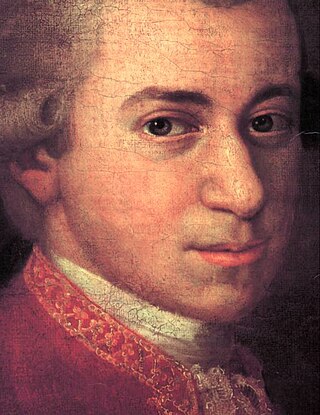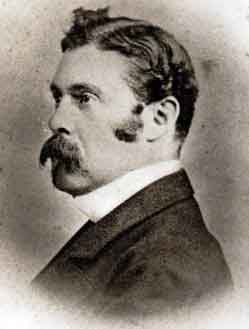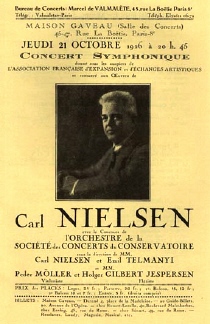
The Petite Symphonie in B-flat major is a four-movement work by Charles Gounod, first performed in 1885. It is scored for a wind ensemble of nine players.

The Petite Symphonie in B-flat major is a four-movement work by Charles Gounod, first performed in 1885. It is scored for a wind ensemble of nine players.
Gounod had composed two symphonies for full orchestra in the 1850s but had since then generally concentrated on opera, songs, and religious music. [1] At the request of a Parisian wind ensemble, the Société de musique de chambre pour instruments à vent , led by the flautist Paul Taffanel, he wrote a nonet for flute and pairs of oboes, clarinets, horns and bassoons. The work was first given at the Salle Pleyel in Paris on 30 April 1885. [2] The score was not published until 1904. [1]
The work, which plays for about twenty minutes, is in four movements: [2]

The Octet in F major, D. 803 was composed by Franz Schubert in March 1824. It was commissioned by the renowned clarinetist Ferdinand Troyer and came from the same period as two of Schubert's other major chamber works, the 'Rosamunde' and 'Death and the Maiden' string quartets.
In music, a nonet is a chamber music composition which requires nine musicians for a performance. The standard nonet scoring is for wind quintet, violin, viola, cello, and double bass, though other combinations are also found. Additionally, the term may apply to a group of nine musicians regardless of whether they are playing chamber music.
Jacques-Nicolas (Jaak-Nicolaas) Lemmens, was an organist, music teacher, and composer for his instrument.

The Serenade No. 10 for winds in B-flat major, K. 361/370a, is a serenade by Wolfgang Amadeus Mozart scored for thirteen instruments: twelve winds and string bass. The piece was probably composed in 1781 or 1782 and is often known by the subtitle Gran Partita, though the title is a misspelling and not in Mozart's hand. It consists of seven movements.
Hyacinthe Jadin was a French composer who came from a musical family. His uncle Georges Jadin was a composer in Versailles and Paris, along with his father Jean Jadin, who had played bassoon for the French Royal Orchestra. He was one of five musical brothers, the best known of whom was Louis-Emmanuel Jadin.
The Op. 33 String Quartets were written by Joseph Haydn in the summer and Autumn of 1781 for the Viennese publisher Artaria. This set of string quartets has several nicknames, the most common of which is the "Russian" quartets, because Haydn dedicated the quartets to the Grand Duke Paul of Russia and many of the quartets were premiered on Christmas Day, 1781, at the Viennese apartment of the Duke's wife, the Grand Duchess Maria Feodorovna. The "Russian" quartets were some of Wolfgang Amadeus Mozart's favorite works by Haydn and in 1785 Mozart dedicated six string quartets to Haydn in admiration of the quartets.
Alexander Glazunov composed his Piano Concerto No. 1 in F minor, Opus, 92, in 1911, during his tenure as director of the St. Petersburg Conservatory. The concerto is dedicated to Leopold Godowsky, whom Glazunov had heard on tour in St. Petersburg in 1905.
Pyotr Ilyich Tchaikovsky composed his Orchestral Suite No. 3 in G, Op. 55 in 1884, writing it concurrently with his Concert Fantasia in G, Op. 56, for piano and orchestra. The originally intended opening movement of the suite, Contrastes, instead became the closing movement of the fantasia. Both works were also intended initially as more mainstream compositions than they became; the fantasia was intended as a piano concerto, while the suite was conceived as a symphony.

Marie-Alexis de Castillon de Saint-Victor was a French composer.

Carl Nielsen's Concerto for Flute and Orchestra was written in 1926 for Holger Gilbert-Jespersen, who succeeded Paul Hagemann as flautist of the Copenhagen Wind Quintet. The concerto, in two movements, was generally well received at its premiere in Paris in October 1926 where Nielsen had introduced a temporary ending. The first complete version was played in Copenhagen the following January. The flute concerto has become part of the international repertoire.
Joseph Haydn's String Quartets, Op. 64, is a set of six string quartets composed in 1790. Along with six earlier quartets published under the opus numbers 54 and 55, they are known as the Tost quartets, after the Hungarian violinist and later merchant Johann Tost who helped Haydn find a publisher for the works. Unlike the earlier quartets, Haydn actually dedicated the Op. 64 set to Tost in gratitude for his efforts.
Sonatas, duos and fantasies by Franz Schubert include all works for solo piano by Franz Schubert, except separate dances. They also include a number of works for two players: piano four hands, or piano and a string instrument.
Serge Jean Mathieu Lancen was a French composer and classical pianist.
The Violin Sonata No. 2 in E♭ major, Op. 102, was written by Camille Saint-Saëns from February to March 1896, and premiered on 2 June 1896 in Paris.